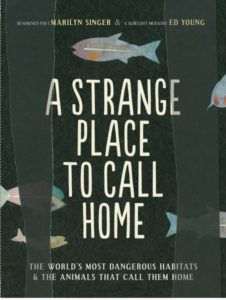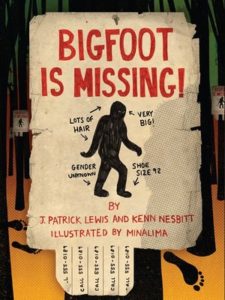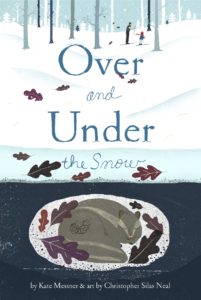 This month’s Industry Insider interview is with Chronicle Books senior editor Melissa Manlove. I first met her in Miami back in 2018 when she gave an inspiring one-day workshop on picture books with Sylvie Frank—I have pages of scribbled notes to prove it! And I’ve been a fan of Melissa’s ever since.
This month’s Industry Insider interview is with Chronicle Books senior editor Melissa Manlove. I first met her in Miami back in 2018 when she gave an inspiring one-day workshop on picture books with Sylvie Frank—I have pages of scribbled notes to prove it! And I’ve been a fan of Melissa’s ever since.
Melissa didn’t go the regular route to a job in the kidlit world. Her college major was Classics, and she also immersed herself in mythology, folklore, Shakespeare, Milton, Chaucer, Hindu religion, poetry, and more. Talk about a wide-ranging liberal arts education!
Now it’s no secret that I’m a fan of Chronicle books, and Melissa’s own list has too many faves to list here, so I’ll simply limit myself to three really fine picture books that I urge you to read.
Now that we’re all pals with Melissa, let’s chat!
https://www.chroniclebooks.com/
RVC: Let’s start by talking about Chronicle. You’ve been there for 16 years. What’s the best thing about working at an independently owned company?
MM: There’s a lot of trust invested in the people making the books—aside from covers, the book making process is the privilege of a very small group who work with the author and artist, and I think that makes space for the selfhood of the book itself.
RVC: That’s a great phrase–“selfhood of the book.”
Among your various superpowers is an ability to translate Latin and Ancient Greek. How did your college degree in Classics prepare you for a career in kidlit?
MM: I’ve forgotten most of my Greek and Latin, but my studies of those languages, as well as Russian, French, and Spanish really helped to underline that each language has its own rhythms and music. That and the background in mythology have been a help to how I understand story as a performance art.
RVC: How IS story performance art?
MM: Not all story is necessarily performed, but picture books—especially for the younger ages–are most often read aloud, and that requires the author to consider how their text informs performance. In my talks, I point out that all of the clues authors leave that might inform performance add up to voice. Storytelling started before writing, and passed from voice to ear to mind long before there was written history, and it is still in the profoundly human circle of firelight and voice (whether the firelight comes from a screen these days or not) that we remember what it means to have a shared story.
RVC: And there’s a great explanation on why so many editors are deeply concerned with a manuscript’s “voice.” Thanks for that!
Speaking of editors, I’ve got a few students at Ringling College who are interested in that as a career. When I tell them that a shockingly large percentage of an editor’s day is spent handling email and attending meetings, they don’t quite buy it. Care to drop a truth bomb on me/them/everyone?
MM: You are so right!
An editor’s job is in the vast majority a communications job—passing and filtering information between designer, production manager, copyeditors, proofreaders, fact-checkers, sales reps, marketing, author, artist, agents … Editors are meant to be the hub of a wheel of people, and the guardian of what the book is meant to be to all its stakeholders. It means that I actually edit and read submissions on the weekends, mostly.
RVC: Let’s dig a bit deeper into the life of an editor. How many submissions do you see in a week?
MM: 10–15 from agents, another 5–10 from writers’ conferences that I’ve taught at. But Chronicle’s Children’s Division accepts unagented submissions, and of those we get about 200 per week.
RVC: What’s your favorite part of a workday?
MM: Editing is always my favorite—talking to writers about the craft of writing; talking about the infinitely varied path toward finding what a boo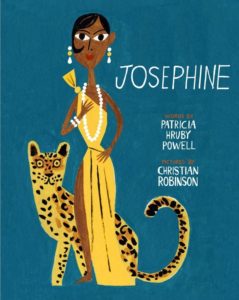 k wants to be.
k wants to be.
RVC: Now I’m going to get all complimenty. It’s clear to me that you’re open to nonfiction picture books that avoid the expected approach, which often is cold precision and a sense of linearity and/or formality.
Take Josephine, for example. That book delivers facts, but it’s got real heart, too.
MM: True stories fascinate me, but even more fascinating is what makes a story feel true. That’s something you could give many names, and yes—heart is one of those. After all, what’s the point of telling kids about the world if we don’t also communicate why we should care?
RVC: Is it fair to say that Josephine—as well as many of your nonfiction books—fundamentally presents a transformation arc? Is that something you’re looking for in submissions?
MM: Often, yes! Readers love a transformation arc because when we see how a character can change themselves, we know we have that power, too. And changing ourselves is changing the world.
RVC: From looking at what you teach at conferences and at Storyteller Academy, rhyme is something you appreciate (when it’s done well). So, let me ask—how do you know when it’s done well? What do you look for?
MM: Poetry of all kinds is aware of the space it occupies—in its rhythms, in its breaths, in its white space on the page. Some people are more naturally attuned to the way language moves through its music. But every poet becomes familiar with the idea of scansion, whether they decide to use its structure to build something, or break it purposefully.
RVC: What’s the easiest way to help aspiring rhymers understand syllabic vs accentual poetry?
MM: The question is which you are counting to make a poem. Haiku counts syllables. Sonnets count syllables and accented syllables. Mother Goose just counts accented syllables. Take Humpty Dumpty—the first and second lines have a different number of syllables than the third and fourth lines. But all four lines have the same number of accented syllables—beats.
RVC: What are a few of your favorite rhyming books?
MM: I love Bubble Trouble, Go to Sleep Little Farm, Goodnight Moon, All the World, Bad Bye Good Bye, I Ain’t Gonna Paint No More…
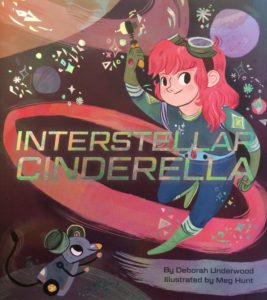 And of course I’m very proud of my many rhyming picture books, which include Interstellar Cinderella and its sequels, Mighty Mighty Construction Site and its sequels, You Are New, Water Sings Blue, Green Is a Chile Pepper, and of course parts of Josephine.
And of course I’m very proud of my many rhyming picture books, which include Interstellar Cinderella and its sequels, Mighty Mighty Construction Site and its sequels, You Are New, Water Sings Blue, Green Is a Chile Pepper, and of course parts of Josephine.
Look for Bathe the Cat and It’s So Quiet coming soon!
RVC: Attendees of your SCBWI workshops on picture book voice rave and rave about them. Now, let’s be honest—if we wanted to really go deep into voice, that’d need to be its own interview. But can you share a misconception about voice that gets writers into trouble?
MM: I think the worst misconception is that a great writer has a single voice. That might be true of reporters. But adapting voice to story, character, mood—that’s what storytellers do.
RVC: In all your experience as a kidlit editor, what has surprised you the most?
MM: There are too many to count or rank!
One of the great gifts of this job is how wide a variety of skills it asks of you, and how wide a variety of experiences it offers. I suppose one is that I’m now teaching public speaking—something I feared and loathed for years. There’s a transformation arc for you!
RVC: What was your secret for moving from a state of fear about public speaking to being comfortable teaching it to others?
MM: The psychiatrist Fritz Perls said “fear is excitement without the breath” and that’s the truth—if you can take a breath and get excited about what you fear, the nervous energy before you go on stage becomes the energy you use to reach out to your audience, and to give them something that matters.
RVC: Love it. Thanks for that!
One last question for this part of the interview. You’ve been a bookseller for a long, long time. Do you still do that? And do you still put on puppet shows?
MM: Sadly, my mother (with whom I did the puppet shows) decided to retire from show business, but I still work at a bookstore on the weekend! I love recommending books.
RVC: Alright, Melissa—it’s time for the SPEED ROUND! Lickety-split questions followed by zappity-fast answers. Are you ready?
MM: Oh! Really? I—
RVC: What’s a secret talent of yours?
MM: Um. I can recite Ladle Rat Rotten Hut from memory?
RVC: If you had to live inside a picture book world for a day, which book would you choose?
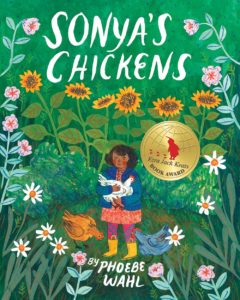 MM: Oh, well, here at the end of 2020 I’m wishing for something cozy. Maybe something by Phoebe Wahl?
MM: Oh, well, here at the end of 2020 I’m wishing for something cozy. Maybe something by Phoebe Wahl?
RVC: How would you use a 30-second ad slot at the next Super Bowl?
MM: Probably for an encouragement to reading aloud to kids. Parents give it up too early and too easy, and it makes a huge difference!
RVC: What’s the One That Got Away?
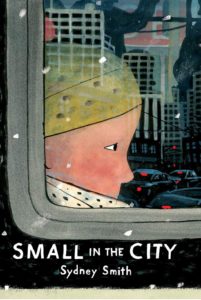 MM: Small in the City. *shakes fist at Neal Porter* (Neal knows I love him)
MM: Small in the City. *shakes fist at Neal Porter* (Neal knows I love him)
RVC: Five things you can’t do your job without.
MM: People! That’s who it’s for.
Kids, educators, my friends and colleagues at Chronicle, my brilliant authors and artists, and my own child self.
RVC: Something your authors and illustrators probably say about you.
MM: Oh no. My anxiety and guilt wants to answer “delinquent”—it’s so hard to keep up with this job, especially in a pandemic year. But I guess what I hope I am to my authors and artists is someone who wants their hearts—what’s best and worst about them, what’s true.
RVC: Thanks so much, Melissa. It was great having you come by OPB!


